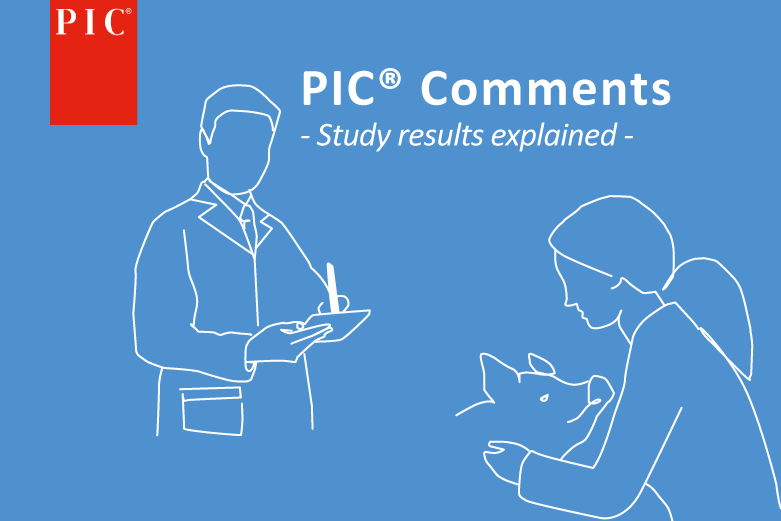Sebastian Casiro, Technical Services Specialist at PIC UK
 Farrowing rate is one of the key drivers of pig farm performance and efficiency, says Sebastian, technical services specialist for PIC. He notes that five areas are pivotal to achieving good farrowing rates: heat detection, the insemination process, semen management, feed management/body condition, and choosing the right females.
Farrowing rate is one of the key drivers of pig farm performance and efficiency, says Sebastian, technical services specialist for PIC. He notes that five areas are pivotal to achieving good farrowing rates: heat detection, the insemination process, semen management, feed management/body condition, and choosing the right females.
Pay attention to heat detection
Heat detection starts with understanding how the heat cycle works, he explains.
“The farrowing rate will be as good as the ability of the farm to find females on heat at the right time,” Seb says. “Missing the heat by just 24 hours can compromise performance.”
He suggests producers identify and mark females that start to show early signs of heat (swelling vulvas, mucous discharge, or ears going up but not locking up when mounted). Let gilts get used to a boar first, then proceed to heat detection, he says.
The following chart (figure 1) indicates the desired window for breeding to achieve a 95% target conception rate.

Source: PIC Technical Services
It’s important to put heavy pressure on a female’s back, to mimic a heavy boar, and “if you’re in doubt, sit on the sow: If she doesn’t move and is silent, it’s the right time to breed her; if she continues to move or make noise, it’s better to wait,” he adds.
Take your time in the insemination process
Breeding is a little bit like an art, Seb says. There can be a general process, but some sows or gilts take a longer or shorter time for the semen dose uptake when utilizing conventional artificial insemination. A sign that the process is too quick is the occurrence of semen back flow. Slow down the process by elevating the end of the catheter.
There isn’t an “exact” amount of time required for the breeding process, because each female is different and employees have different levels of expertise.
“Gilts make up a special group and must be treated as such,” Seb says, adding that a 3-minute average is more than likely not long enough. Also, if the employee see semen back-flow, it indicates something is wrong.
Remember semen quality
Keep semen alive and strong, states Seb, and remember that semen age is relevant. “Over- ordering may force you to use older semen,” he says. “Semen doses can limit total born numbers by 0.3 pigs and impact farrowing rate by 2% per day of if storage is incorrect and compromised, so it’s better to receive semen more frequently – for instance, three times a week.”
Semen temperature is important, too. “Semen must be stored between 16° C and 18° C,” Seb recommends. “Even a 2-degree fluctuation can reduce shelf life up to one day!”
Unpack semen doses before putting them in the controlled temperature cabinet and store doses loosely and horizontally to allow for air circulation. Check temperatures in the storage unit daily, and when semen is removed for use, put it in an insulated container with gel packs to maintain temperature. Post-cervical artificial insemination (PCAI) low sperm cell doses are more sensitive to temperature fluctuations and need special attention, Seb adds.
“It’s a one-way road,” he says. In other words, any semen not used in the service area should not be put back in the control box for future use. Breeding staff should know how many sows or gilts will be serviced to avoid taking too many doses to the service area.
Focus on feed management and body condition
Monitor sow body condition on a weekly basis to avoid breeding females that are either too fat or too thin, Seb notes. Set reminders so this is a regular occurrence, and calibrate feeders accordingly. He suggests producers evaluate groups at breeding, and at 4 weeks, 8 weeks, and 12 weeks of gestation.
“Consider using a caliper to make the body condition evaluation objective to tailor your feeding program,” he says.
Wean-to-service interval and breed-back times are both good indicators of body condition management and proper lactation feeding.
“When feeding is done correctly, a greater number of sows can be bred on days 4 and 5 post-weaning,” he says.
Choose the right females
Culling should be used as a management tool, and producers should make a regular habit of eliminating the bottom 10% of the females in their herds. Culling allows producers to limit the number of older parity females on the farm, while also removing younger parity sows who aren’t performing well or are having an issue that won’t allow them to deliver another litter.
“Achieving the right breeding target will always be a priority, so work on optimising gilt entry and reducing involuntary culling,” Seb says.
Lameness is often the primary reason for involuntary culling. To minimise this factor:
- Select gilts with good feet and leg structure
- Control body condition
- Consider using copper sulfate (to avoid excess humidity on the floor) if you see major lameness issues coming from cracked hooves or sole lesions.
Fill pens with sows of similar size and parity if group housing is used. Also, ensure the right quantity and quality of gilts are entering the farm, focus on puberty induction, and treat the gilt-development unit as the future of the farm by making it a priority, Seb says.
Details matter when it comes to improving farrowing rates. “Each action may have a small impact alone, but can have a huge collective impact. Understanding the drivers of farrowing rate and implementing tactics to improve it will bring better performance,” Sebr says.
For more information contact your PIC team.



